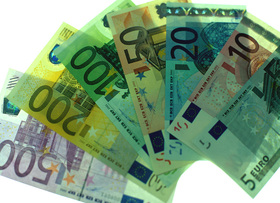Euro

- (Photo: European Commission)
The name of the single EU currency - formerly named the ECU. 1 Euro = 100 cents.
Introduced from 1st January 2002 in 12 of the 15 EU Member States. After 30th June 2002 all national coins were melted down and notes burned.
The Euro coins have an identical EU-wide design on one side and different national designs on the other. There are 1, 2, 5, 10, 20 and 50 cents coins, as well as 1 and 2 Euro coins. The coins have been criticised for causing a nickel allergy.
The Euro bank notes are identical throughout the EU and have no national features. There are 5, 10, 20, 50, 100, 200 and 500 Euro notes.
Membership of the Euro-area means that national coins and notes are no longer valid
Britain and the Euro
The current British governement is committed to joining the euro but on the proviso that the British economy first passes 'five economic tests' and that membership is supported by a national referendum.
The tests were devised by British Finance Minister Gordon Brown, and are designed to ensure that the British economy is compatible with those of the countries inside the eurozone prior to Britain joining the single currency. At present, it is unclear how many of the tests Britain passes, it clearly does not meet the requirement for 'structural convergance'.
Links
See also Economic and Monetary Union, Euroland, Optimum currency area.
http://euro.eu.int
http://www.euro.ecb.int
